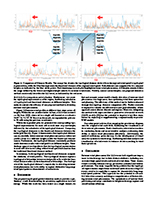Topological Guided Detection of Extreme Wind Phenomena: Implications for Wind Energy
 Comparing Topological Guided Detection with Traditional Detection methods, the top middle plot displays a wind
speed profile from 10 to 260 meters, highlighting the relevant range for phenomenon occurrence. A distinct curve depicts the
category of extreme phenomena impacting wind turbine operations. The left plot presents the sampled regional wind speed
profile at three heights alongside its corresponding topological representation. The right plot showcases regional wind speed
profiles across all region of interest heights for extreme wind phenomena. The bottom middle plot illustrates the distance function
for our method and the traditional approach. Notably, our method requires computation of only a few distances,
effectively capturing significant wind speed changes over a broad regional scale. Unlike traditional detection, it eliminates the
need for cross-height wind profile comparisons.
Comparing Topological Guided Detection with Traditional Detection methods, the top middle plot displays a wind
speed profile from 10 to 260 meters, highlighting the relevant range for phenomenon occurrence. A distinct curve depicts the
category of extreme phenomena impacting wind turbine operations. The left plot presents the sampled regional wind speed
profile at three heights alongside its corresponding topological representation. The right plot showcases regional wind speed
profiles across all region of interest heights for extreme wind phenomena. The bottom middle plot illustrates the distance function
for our method and the traditional approach. Notably, our method requires computation of only a few distances,
effectively capturing significant wind speed changes over a broad regional scale. Unlike traditional detection, it eliminates the
need for cross-height wind profile comparisons.

Demi Qin

Graham Johnson

Brian Summa
Extreme wind phenomena play a crucial role in the efficient operation
of wind farms for renewable energy generation. However,
existing detection methods are computationally expensive, limited
to specific coordinate. In real-world scenarios, understanding the
occurrence of these phenomena over a large area is essential. Therefore,
there is a significant demand for a fast and accurate approach
to forecast such events. In this paper, we propose a novel method for
detecting wind phenomena using topological analysis, leveraging
the gradient of wind speed or critical points in a topological framework.
By extracting topological features from the wind speed profile
within a defined region, we employ topological distance to identify
extreme wind phenomena. Our results demonstrate the effectiveness
of utilizing topological features derived from regional wind speed
profiles. We validate our approach using high-resolution simulations
with the Weather Research and Forecasting model (WRF) over a
month in the US East Coast.
TBD



